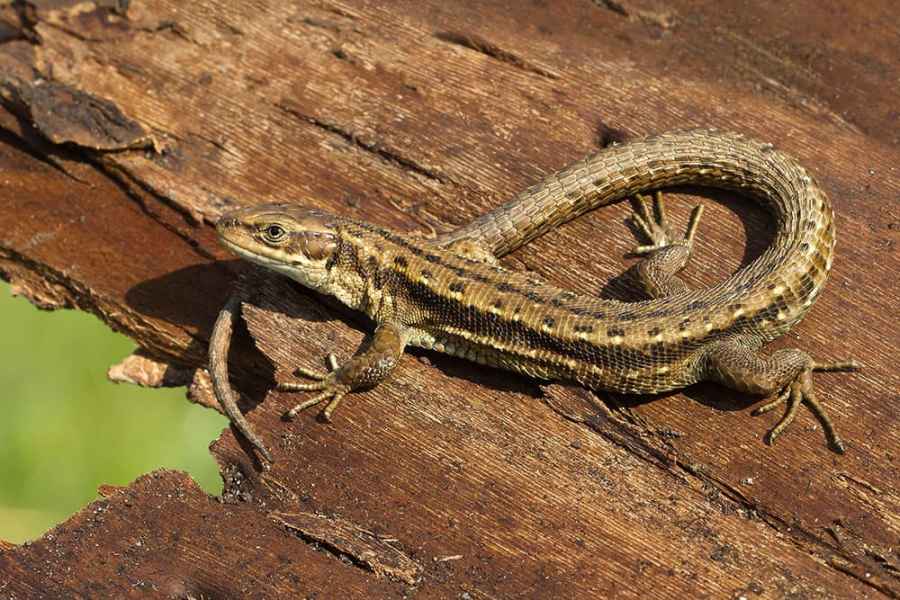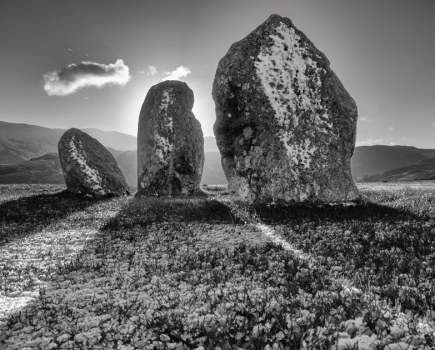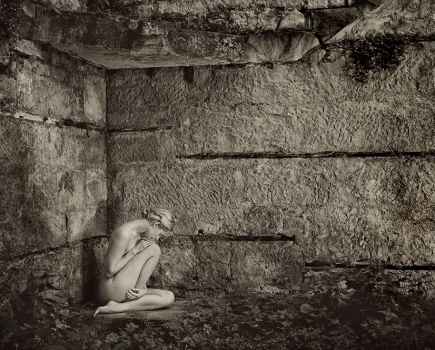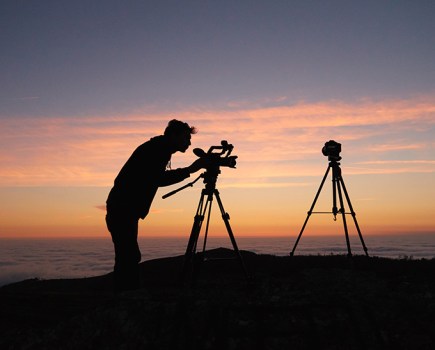Love them or hate them, it can’t be denied that reptiles can make for stunning images when photographed well. But these prehistoric-looking creatures have managed to survive in today’s world by avoiding being seen. Many people have never even seen a reptile in the UK. So how do you photograph these elusive beauties? In most cases you’ll need one of two things – a great deal of luck or a great deal of patience.
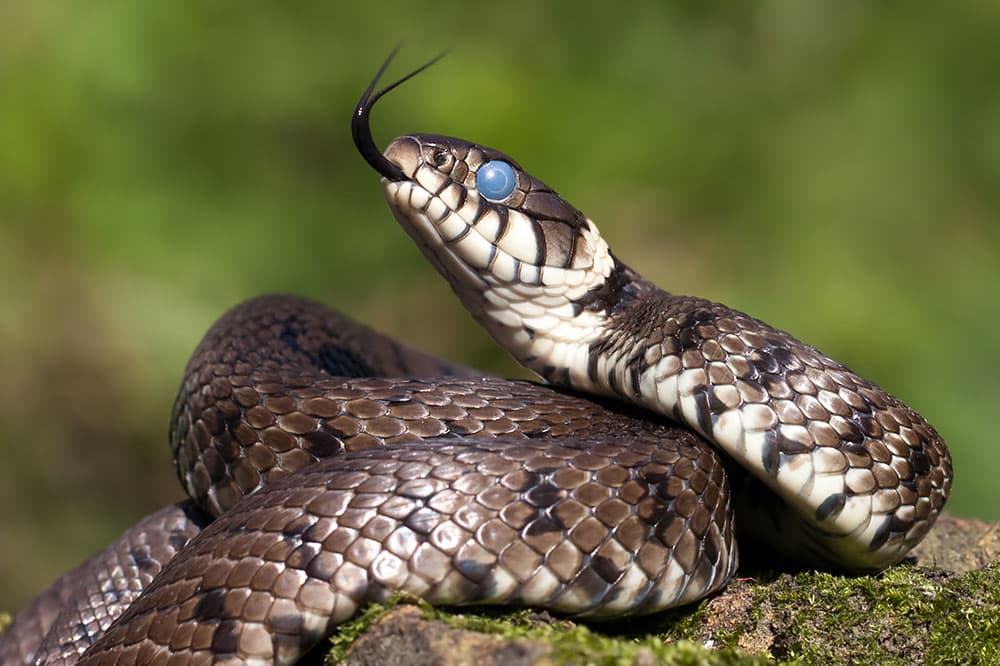
A shutter speed of 1/1000sec has caught this grass snake flicking its tongue to taste the air.
The UK has six native species of reptile and all are afforded some degree of protection by UK and European law. Common adders, grass snakes, slow worms and common lizards are all protected by law against being harmed or traded in any way. Our rarest of reptiles, the sand lizard and smooth snake are fully protected by law, making it an offence to disturb them without a licence issued by Natural England. So unless you already have a licence the only way you are likely to photograph these creatures is by accompanying a licence holder. From here we will concentrate on the four remaining species that you are most likely to find and, hopefully, photograph.
Species to photograph
Slow worms are in fact legless lizards and they can be found in heathland, tussocky grassland, woodland edges and even gardens, where they often hunt slugs and other insects around compost heaps.
Viviparous, or common, lizards are not as common as their name suggests, but they can still be found across the UK. They have adapted well to many environments and can be seen in a variety of habitats including gardens, heathland, woodland edges and glades, open meadows, log piles and hedgerows. Grass snakes are the UK’s largest snake species and particularly favour wetland habitats, but they can also be found in grassland near streams or rivers, or even gardens where there is a pond nearby allowing them to feed on amphibians, or a compost heap where they can incubate their eggs.
Adders are the UK’s only venomous snake, but they are not aggressive animals and will only use their powerful venom as a last resort. They are regularly associated with heathland, rough, open countryside, chalk grassland and woodland edges or clearings within dense woodland.
Finding reptiles
As with any wildlife photography knowing your subject is key to getting the images you want. Read up on the species you’re aiming to photograph, this will help you find and get close to the reptiles. Reptiles are cold-blooded, so they rely on the sun’s rays to warm their scaly bodies, and the best way to find them is to catch them basking in the sun. Different species favour slightly different habitats, but they all rely on open basking areas adjacent to vegetation where they will quickly disappear for cover if disturbed. During the summer reptiles warm up much quicker meaning they need to spend less time basking, so the best time to see them is either in the spring or autumn. The most successful days will be ones with warm hazy sunshine following days of rain when the reptiles will have been unable to bask. Reptiles are quite nervous creatures, and easily spooked, but using a few simple tips you can get close enough to photograph them.
Approach south-facing potential basking areas with the sun behind you, but watch where your shadow falls, as casting a shadow on the reptile could send it fleeing for cover. Reptiles have a great sense of smell, especially snakes, who flick their tongue back and forth tasting the air for the slightest trace of possible predators. With this in mind, it’s best to approach from downwind and avoid wearing any aftershave, perfume or heavily scented deodorant. Both lizard species have good hearing but snakes are technically deaf. Although they can’t hear you chatting between yourselves, they will pick up the slightest vibrations in the ground, so walk slowly and tread softly.
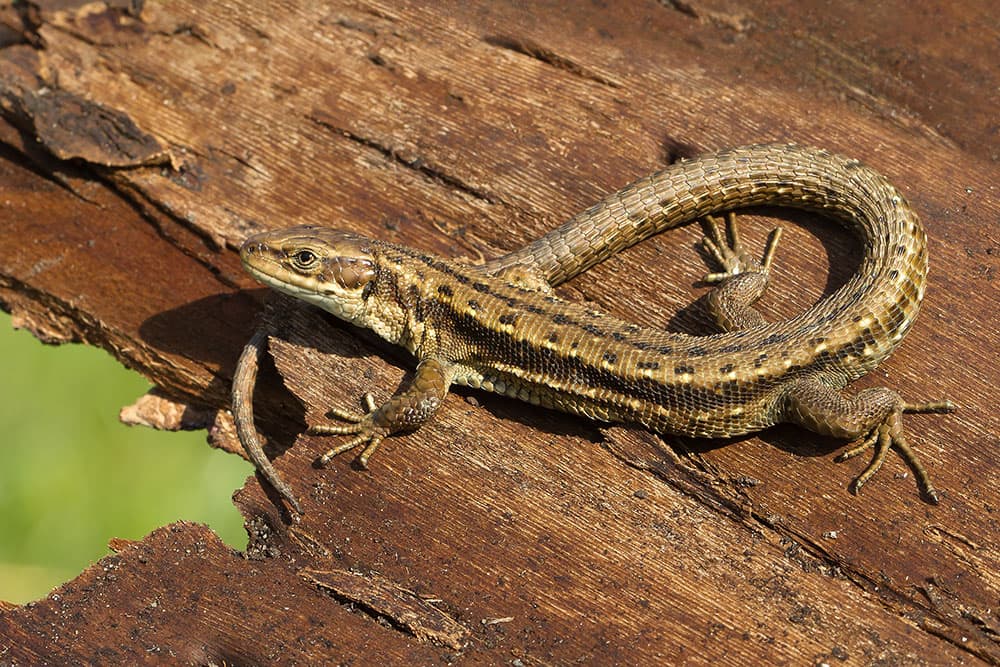
The excellent detail on this vivaparous lizard was caught using a macro lens
Respecting wildlife
Reptiles are creatures of habit. They regularly use the same basking spots each day, and if disturbed accidentally they will often return to the same spot within half an hour if you remain very still and quiet. Once you have learned where they are likely to be you can arrive at the start of the day and get your camera set up ready for their emergence in the morning as the ground temperature rises.
With the recent rise in interest in photographing reptiles, it is worth discussing the need to respect these beautiful creatures. If you take the time to learn their habits and patterns you will be rewarded with the opportunity to get great photos without the need for disturbing them. Catching and handling reptiles, especially snakes for the purpose of photography, can be extremely detrimental to their heath and should be avoided. This practice has become quite common lately and is likely to be one of the contributing factors behind the decline in numbers of reptiles found at many sites. It’s something I was previously guilty of until I became aware of the severity of the negative impact such actions can have on reptiles, especially snakes.
Minimal disturbance
If caught, lizards have a useful trick to evade capture. They can drop their tails, which will simply break off and continue to thrash about to distract the potential predator’s attention whilst the lizard makes its escape. Although lizards can survive without their tail, which will eventually grow back to some degree, their tails contain vital fat supplies used to sustain them throughout the winter hibernation months.
Adders are very easily stressed, and excessive disturbance can cause them to stop feeding, or in extreme cases abandon the site and go off in search of a new location where they will be left alone. Obviously such sites are very difficult for the adder to find so it may end up starving to death or freezing when the weather turns cold, as it no longer has access to its known and trusted hideaways. Naturally, there is always the risk of being bitten when handling an adder. Adder bites can be very serious and usually require medical attention. They will not attack humans, but they will defend themselves if they feel threatened, so it’s best to keep a respectful distance. A 300mm lens is perfectly sufficient to achieve frame- filling shots without disturbing the snakes.
Image that works
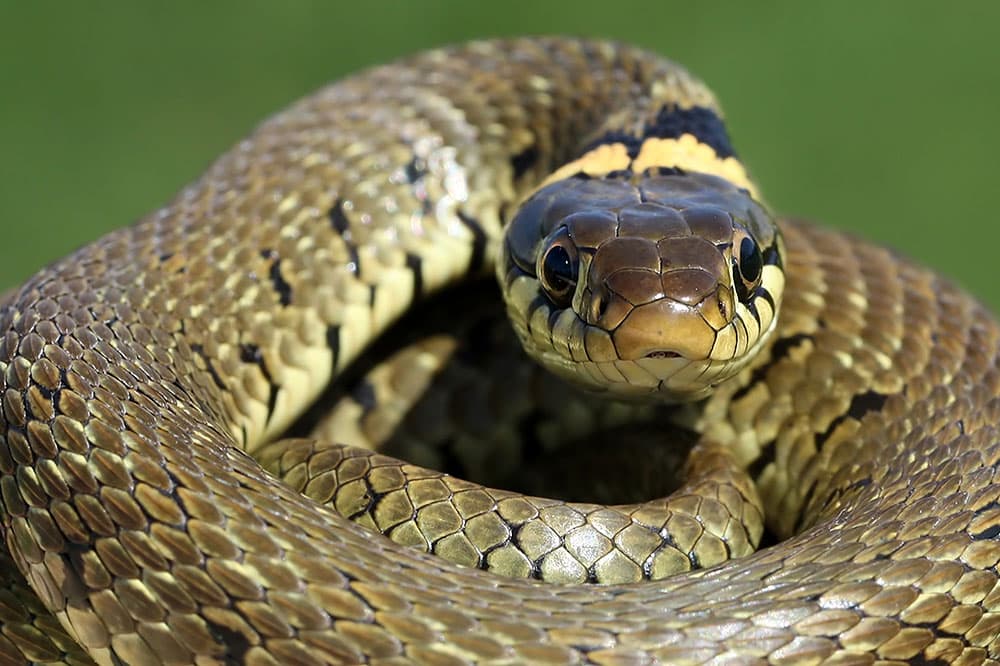
This grass snake was photographed as it basked at the edge of a stream on a raised bed of reeds. The eye contact makes it an engaging shot and conveys the snake’s indecision over whether it should remain motionless or disappear.
It was taken with natural lighting. A reflector may have helped to even the light distribution on the subject, but the photo was shot in raw format that allowed me to lower the contrast slightly and lift some of the harsh shadows caused by the bright midday summer sun later. The snake’s tones work in harmony with the foliage in the background. The fairly shallow depth of field isolates the subject and gives it a three- dimensional quality.
Photographing reptiles – 5 top tips
- As with most wildlife images, forming a connection with the viewer is best achieved by focusing the camera on a subject’s eyes and taking images at eye-level. With reptiles, this usually means getting down on the ground. At this level, the camera will be well supported by resting your elbows on the ground or on your kit bag.
2. The most striking images of snakes often depict the snake’s tongue flickering back and forth. To capture this you’re going to need a fast shutter speed of at least 1/400sec. The faster the speed, the greater your success rate. Shooting image bursts with the camera on high-speed mode will greatly improve your chances of capturing the flickering tongue in perfect position.
3. Most reptiles won’t be found completely out in the open very often, and when you’re trying to photograph them you may find your images end up with untidy backgrounds behind the subject. Unless you plan on entering your images into competitions, there’s nothing to stop you from cleaning up the backgrounds in Photoshop with some selective blurring and cloning work.
4. Some reptiles, especially common lizards early in the morning, may be brave enough to allow you to use a macro lens resulting in some really striking images. You’ll need to move very slowly and allow the reptile time to feel safe in your presence. You might even get the opportunity to use a wideangle lens. Using a small aperture affords you a great depth of field and allows you to create effective images showing the reptile in its natural environment.
5. The best way to encounter reptiles and to learn more about their behaviour is to get involved with your local volunteer Amphibian & Reptile Group (ARG). These conservation-and- recording groups can give you great advice and help you to get involved with surveying for reptiles. To find your local ARG group visit www.arguk.org.
Jason Steel
Jason Steel is a keen wildlife photographer. He is actively involved with herpetology conservation as a committee member for the volunteer recording-and-conservation organisation Kent Reptile & Amphibian Group. His images are regularly used by many wildlife and conservation groups and charities. Visit www.jason-steel.co.uk.

